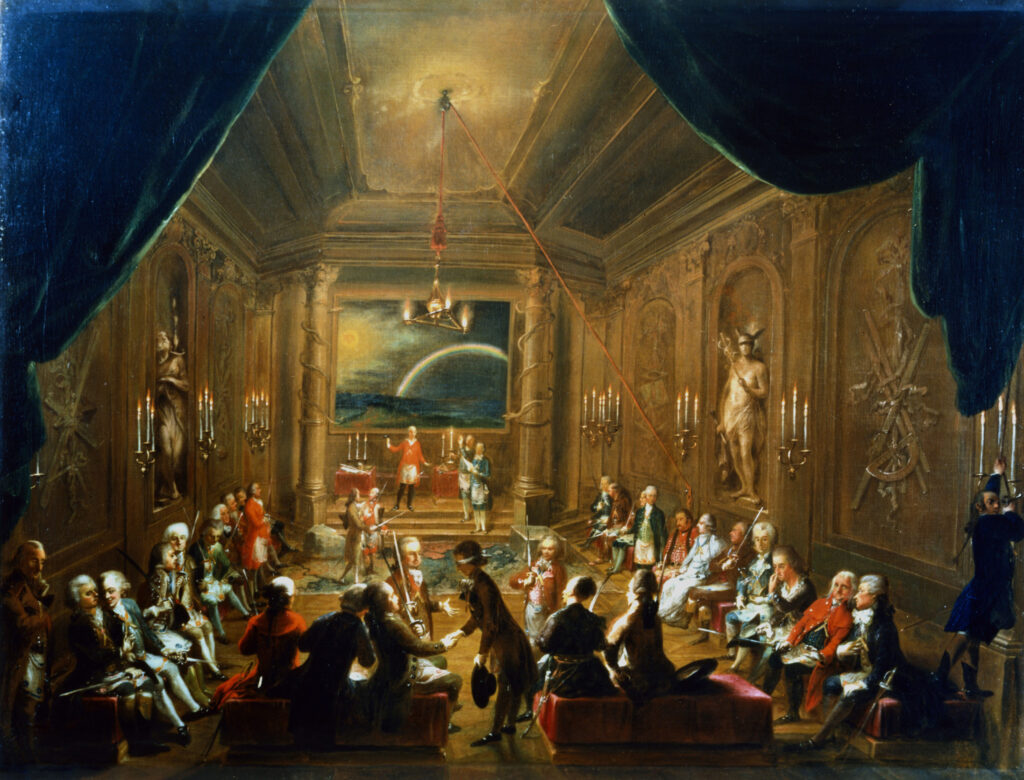Certainly the most thorough and dedicated historian of the late Enlightenment in Moravia is the art historian Jiří Kroupa. His lifelong research is summarised in his book called Alchymie štěstí – Pozdní osvícenství a moravská společnost 1770–1810, which traces the social structure and transformation of the landed gentry into a courtly aristocracy.
Kroupa showed how new salons were gradually established, in which women (Marie Eleonore of Dietrichstein) were sometimes able to make a significant mark. Most interesting are the descriptions of the individual salons and the attempt to describe their development and their relationship to state politics. This is where Kroupa’s exploration of the “alchemy of happiness” begins as he identifies Freemasonry and secret societies in Moravia as one of the most important symptoms of this new paradigm.
The greatest activity of Freemasons in Moravia dates back to the first phase of the late Enlightenment – that is, to the 1870s to the 1890s. This can be well documented by the example of three “Freemasonic” operas: Tarare by Antonio Salieri (later used by the author for the Austrian recycling of the original French opera for Paris 1787), Don Giovanni by Wolfgang Amadeus Mozart (Praha 1787) and his purely Freemasonic Zauberflöte (Vienna 1791).
Similarly to Mozart, Salieri’s Masonic activity was consistent with a situation in which, in early Josephinism, Masons could be seen as collaborators in the creation of a modern bureaucratic state in which the sovereign and all institutions were bound by law. Joseph II aspired to transform Austria into such a state, and his decade of independent rule (1780–1790) marked an almost revolutionary transformation of society in its relationship to the subjects, the church and the nobility. Joseph II’s departure from Freemasonry came only when the monarch realized that this political grouping had its own strategy in addition to his own, which he favoured.
Salieri’s Tarare, a distinctly Masonic tale of the search for a wise ruler who is and wants to be subject to the law, was a great success in Paris in 1787. However, it was more of a manifestation of the tense situation than a musical success as when the tiers état was about to emerge and gradually take power.
Mozart was similarly political. In Don Giovanni, based on a libretto by Lorenzo da Ponte, he invites the bridal party to his palace, he does so with the line that the gates are open to everyone and long live freedom. This multiple celebration of freedom must have been extremely impressive at the time.
Zauberflöte, the next “Masonic” opera, already brings a number of Masonic symbols, and although the librettist Schikaneder used his sort of Masonic existence to offer the almost suburban and “folk” audience of Vienna a colourful mixture of Masonic symbols mixed with the altered tastes of the time, and the libretto itself is such a heterogeneous mixture, they are cemented by Mozart’s brilliant music. Surely, this was to silence Freemasonry – as well as Libertinism – in Austria for a long time.
If in the 1980s and 1990s there were “Masonic” operas and other transpositions of Masonic ideas into music, literature and even the visual arts, the Napoleonic Wars and the onset of reaction after the Congress of Vienna put a definitive end to all manifestations of the previous libertinism (most notably in da Ponte and Mozart’s Cosi fan tutte), as well as to echoes of Freemasonry and any links to the previous Enlightenment.
Furthermore, the talk will include a look at what was common at this time: life in private salons – aristocratic and later bourgeois – using the example of the von Haugwitzs. After the Congress of Vienna, father and son Heinrich and Carl Wilhelm von Haugwitz retreated into a kind of universally respected privatissimo of their castle and their subculture. After 1800, the musical productions at the castle in Náměšť and Oslavou were oriented towards one significant and new phenomenon: historicism and the discovery of the music of older generations. Systematically, Heinrich von Haugwitz explored the music of Händel, Naumann and others. However, it was possible to document and explain the tendency in this context as a phenomenon originating in the circle of Gottfried Freiherr van Swieten, son of Maria Theresa’s court physician, whose concerts grew into systematic activities (sort of a concert companies) and eventually resulted in the activities of the Gesellschaft der Musikfreunde. Gradually, it spread to other aristocratic residences.
In addition to the older music revival, Heinrich von Haugwitz maintained his contacts with Salieri, Beethoven, and perhaps Schubert and others, which is evidenced by Salieri’s letters to him, on the dedication of autograph scores and many other circumstances. However, the situation somewhat changed after the death of Heinrich von Haugwitz. While performances and concerts in his time attracted a relatively large audience, his death was followed with closing down the entire salon. Needless to say is that this was already a completely new situation in the 1840s–1870s.
Author: prof. PhDr. MgA. Miloš Štědroň, CSc., composer, musicologist, university professor



